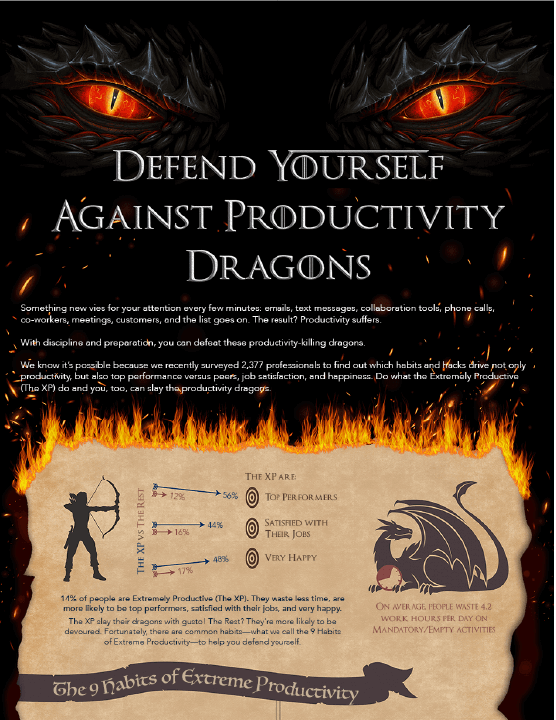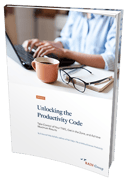Take a moment to think about a time when you had a period of deep focus in which your work performance and productivity were at a high. Everything clicked. You nailed the deadline. Made the leap. Produced 10X. Everything came into focus.
Wouldn’t it be great if you could have that level of focus and achieve that extreme productivity all the time—or even most of the time?
What about if you could control when you get in that zone and become unstoppable?
As it turns out, you can. You can follow proven habits used by the most productive people (or The Extremely Productive—The XP) to get in the zone and get the most done.
What’s more, as our global productivity research reveals, do so and not only do you improve your chances of being a top performer, you’re more likely to be satisfied with your job and happier!

Becoming more productive, maximizing motivation, and achieving results is about having the right habits and routines. It becomes part of the way you approach your work and your life.
First, it’s important to understand what productivity is and how it can be improved.
How Do You Be Productive?
Productivity is often misunderstood.
One person might think being productive is conquering their never-ending inbox by the end of the day, while another perceives it as working as many hours as possible.
Here's the thing: it's not about getting through your email, and it's not about being a workhorse and cranking out eight or more hours of work every day.
It's about working smarter and rethinking how you spend your time.
The 4 Levels of TIME
Everything you do, every minute of your day, falls into one of these 4 Levels of TIME.

What Do Highly Productive People Do?
So how can you best maximize your time? Is it possible to learn how to be productive?
To find out, we studied and analyzed the work habits and behaviors of 2,377 people. We used a statistical test called a key driver analysis to assess the relationship between these behaviors and productivity (as well as performance, job satisfaction, and happiness).
We found that 12 of the behaviors we studied were key drivers of extreme productivity. Extremely productive people (The XP) are significantly more likely than The Rest to do these things.
12 Key Drivers of Extreme Productivity
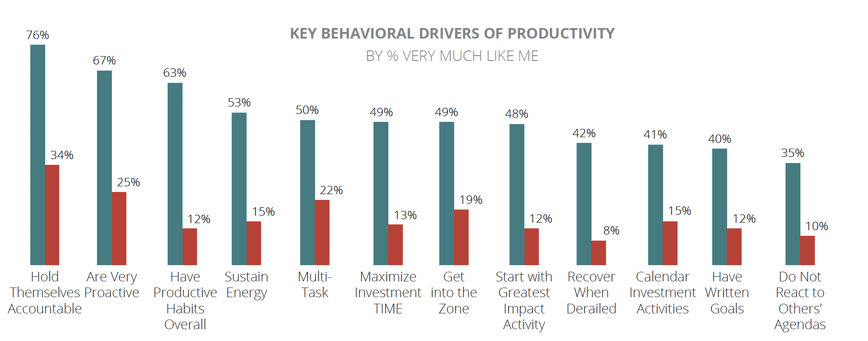
- Hold yourself accountable: Do what you say you’re going to do, and regularly check in on yourself.
- Be very proactive: Drive your own agenda to accomplish more.
- Have productive habits overall: Change your habits to maximize productivity.
- Sustain energy: Prioritize doing things that help refill your tank so you can keep going.
- Multi-task (with care): Balance priorities, but don’t get distracted when you’re focusing on one of them.
- Increase Investment time: Prioritize your greatest impact activities and focus on them intensely.
- Get into the zone: “The zone” is a state of intense focus and attention which allows for higher levels of performance. When you work in the zone, you’re fully engrossed in what you’re doing.
- Start with the Greatest Impact Activity (GIA): Begin your day working on your most important activities, when your energy is at its highest.
- Recover when derailed: We all get distracted and derailed. Swiftly rebound and get back on task.
- Calendar Investment activities: When you put something in your calendar, you’re more likely to do it. Block off time to work on activities that generate an outsized return.
- Have written goals: Define your goals. If you don't know what you want or where you're going, it's easy to spin your wheels.
- Do not react to others’ agendas: Be the master of your own schedule by learning to say no.
9 Habits of The Productivity Code
Beyond individual key drivers, our research looked at patterns of productivity. It turns out there are nine habits the most productive people use to drive predictable productivity and performance.
In The Productivity Code, we group these nine habits into three categories or keys.
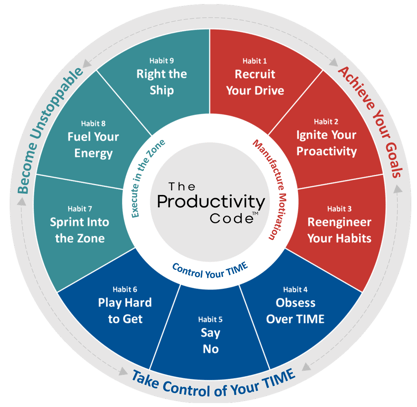
In this post we share 27 practical productivity tips based on the nine habits of extremely productive people. Plus, download an infographic on how how you can build healthy habits and slay your productivity-killing dragons.
Click the infographic to enlarge (PDF).
Key #1: Manufacture Motivation
Motivation is commonly thought of as fixed; you either have it or you don't. Yet research shows we all have motivation inside of us, we just need to draw it out. We can improve it like a skill. We can build it like a muscle.
Habit 1: Recruit Your Drive
Your drive is there. However strongly you feel it now, you can recruit it to be even stronger if you know what to do.
The Extremely Productive (The XP) know how. They’re more than twice as likely to be very driven compared to The Rest.
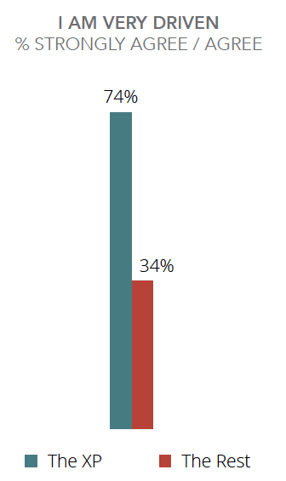
Tip 1: Choose Your New Reality
If you want to make work (or any task) meaningful to you, you need to first choose your New Reality. Your New Reality is your big picture goal, the destination of your journey. It could be meeting your sales quota of $500,000 this quarter, losing 10 pounds in the next eight weeks, launching a new product by May 1. Think about what you want to achieve and write it down.
Tip 2: Plan Your Actions Weekly
After you’ve written your goals, build a specific action plan to achieve them. When you know your goals (your New Reality) and connect them to your actions, those actions become more meaningful. They feel less like drudgery even if they’re the same actions that drained you in the past. When you choose where you want to go, the actions you need to take to get there also become your choice. And having that choice is motivating.
A strong focus on weekly actions—just 20 minutes a week planning them—will focus what you do and help you feel motivated to do it.
Tip 3: Track Progress Weekly
Finally, don’t just plan your actions weekly, track them weekly—preferably with someone else. Planning actions and tracking them with an accountability partner is a powerful force in recruiting your drive.
Habit 2: Ignite Your Proactivity
Getting started is hard. For most people, a catalyst helps them get going.
We’ve identified three catalysts that can help you get started on important tasks by lowering the perceived and actual activation energy required. Try them and you’ll ignite your proactivity.
Tip 4: Calendar Investment Time
If you put it on your calendar, you're much more likely to do it. Our research shows the most productive people are 2.7 times more likely to block off time in their calendar every week to work on their greatest impact activities that will drive the best results.
Actively dedicate time to your most impactful tasks: the areas where you want to invest your time that will help you achieve your goals.
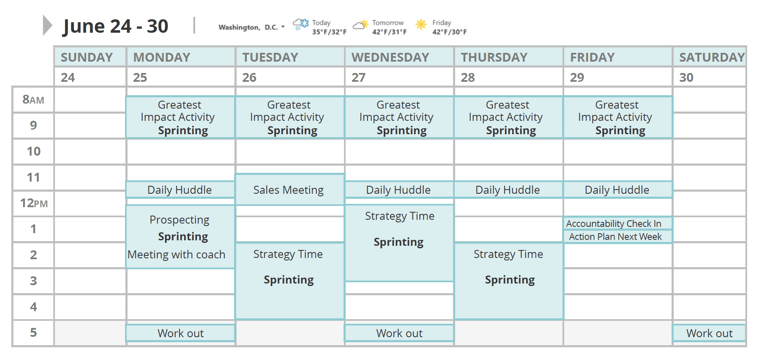
Tip 5: Talk to Yourself
The average person says between 300 and 1,000 words to themselves every minute and this inner voice can be a harsh critic. You want to change the negative self-talk into positive self-talk. Here are some examples of negative self-talk and how you can flip them around.
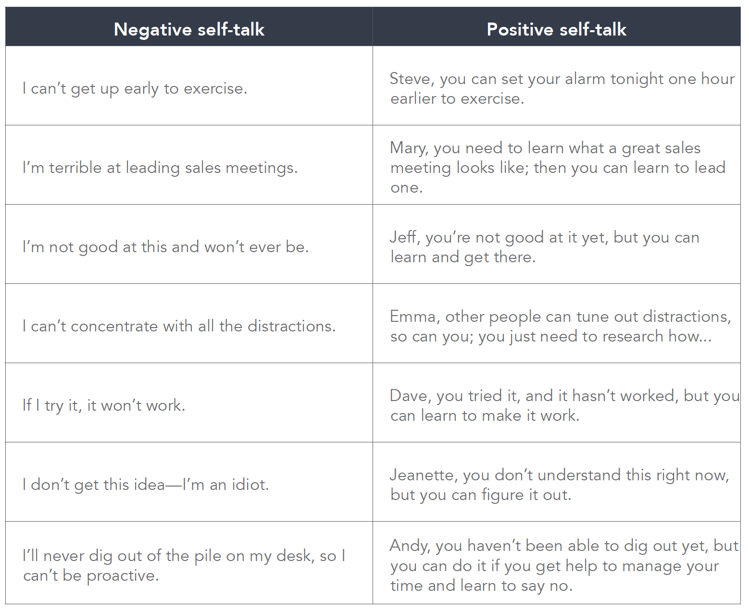
As you might imagine, the most productive people (The XP) are much more likely than The Rest to practice positive self-talk; 2.4 times more likely to be exact. Moreover, the happiest people are 2.3 times more likely to use this hack, as well.
Tip 6: Say, “3, 2, 1…Go!”
You have a short amount of time to get started on something before your brain tells you it's too hard. All you have to do—like any school-aged child ready to start everyone racing—is say, “3…2…1…Go!” and immediately get started.
Habit 3: Reengineer Your Habits
You must do things differently, and do different things, if you want different results.
If you want to do anything differently, you need to understand your habits and know how to change them.
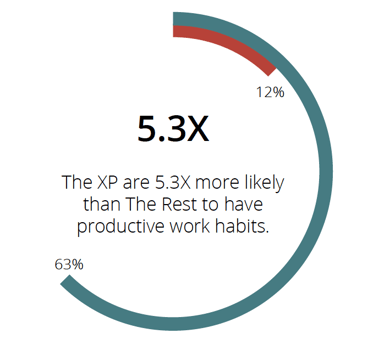
In fact, having productive habits is one of the key drivers of productivity and the factor that most separates The Extremely Productive from everyone else.
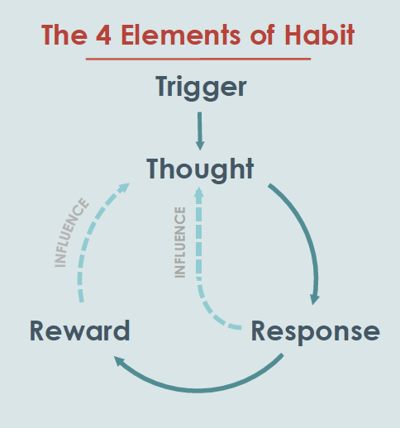
Tip 7: Say, “When I, Then I. Will I?”
Research has shown that making “When I, Then I” statements works to change habits. For example, to break my morning mindless internet browsing habit, I said, “When I turn my computer on in the morning, then I’ll focus immediately on my Greatest Impact Activity for the day.”
This is what the most productive people do.

Then, for the most important of your desired actions, ask, “Will I?” in the morning. According to research, you then give yourself the best chance of actually doing it.
Tip 8: Change your environment
Your location can act as a trigger itself. Consciously or subconsciously, it can affect your thinking. Which affects your actions. Which affects your responses.
For example, being in the office is not the best location for me when I need to write. The office environment itself is a trigger and I don’t get much writing done when I’m there. But, put me in my study at home and the words flow.
The other way we can change our environment is to be in the same place, but change conditions.
For example, if you don’t want to be distracted by your phone, take it off your desk, mute it, and put it in a drawer—or another room. Noise, music, clutter, browsers, inboxes, chair, door open or closed, and so on. All these environmental factors affect your productivity one way or another.
Tip 9: Make your morning routine sacred
A keystone habit of extremely productive people is to have a consistent morning routine that starts the day off right. More than half of The XP have a morning routine that gets them off to a productive start each day, as opposed to just one in four of The Rest.
For many people our 5-Step Extreme Productivity Morning Routine has been the productivity hack that has made all the difference for them.
Key #2: Control Your TIME
Our productivity research shows most people spend an average of 4.3 hours per workday on Empty (wasted) and Mandatory (could be delegated or simply not done) activities. That’s about half of every workday down the productivity drain.
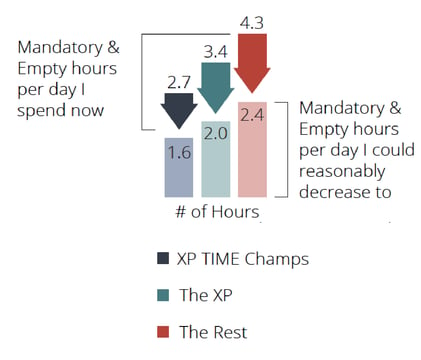
But with the right mindset and tools, you can completely redefine how you spend your time.
Habit 4: Obsess Over TIME
Most time management systems are more complex than they need to be.
Do (and don’t do) a few simple things and you can reclaim significant lost time, then spend that time the way you want.
Tip 10: Take T, Increase I, Minimize M, and Eliminate E
Pay attention to the big picture.
Categorize your activities into the four levels of time and make a conscious effort to take Treasured time, increase Investment time, minimize Mandatory time, and eliminate Empty time.
If you spend your time wisely, you’ll find yourself with more time available for Treasured activities. In fact, according to our research, the most productive people are twice as likely to take time for Treasured activities.
Tip 11: Track Your TIME
Delegating, eliminating, or minimizing your Mandatory and Empty time means changing habits. It’s hard work. Tracking your time by keeping a time log is simple and it’s the best place to start.
You may think it sounds boring, but in reality it doesn’t take that long and the payoff is high. If you want to optimize your time, you have to know where you’re spending it. Track your TIME.
Tip 12: Put Your GIA First
One way to get the best return on your time investment is to focus on your Greatest Impact Activity (GIA), a key driver of productivity.
 Your GIA is the one activity that, should you do it consistently at high quality, will get you the greatest eventual return on your time investment.
Your GIA is the one activity that, should you do it consistently at high quality, will get you the greatest eventual return on your time investment.
In our research, we found that the most productive people are 4x more likely to start their day with their GIA.

Why put your GIA first? There’s a large body of research suggesting that energy, memory, concentration, and analytical skills are better in the morning for most people.
Habit 5: Say No
Saying no is about setting boundaries.
It's not about being difficult or not being a team player. It is about taking total control over what you do and what you avoid. When you say no, it makes what you say yes to that much more important.
Tip 13: Keep a To-Don’t List
Keep an active “no” list, so you know which activities to avoid. Everyone has a to-do list. Everyone needs a to-don't list. Items on your to-don’t list can be temporary or permanent. You can think of your to-don’t list as a parking lot for ideas that aren’t topping the priority list now. It may not be no forever. It’s no for now.
Tip 14: Do Less. If It’s Not Gung-ho, It’s No
For your Investment activities, if you’re not fully enthusiastic about doing it and the return it’ll get you, say no. Don’t do it.
If you have simultaneous priorities, ask yourself, are they all getting done to your satisfaction? Do you have too many goals, too many objectives, too many projects going at once?
Be brutal about paring the list down. You don’t have to delete the priority; you can move it to your to don’t list. Then you can focus on the top priorities; the few that will get you the greatest return.
Do less. If it’s not gung-ho, it’s no.
Tip 15: Practice Saying No
You can learn to set boundaries even if saying no is a real challenge for you.
Something that can help all of us who legitimately struggle here is to practice saying no. As therapist Darlene Lancer, author of How to Speak Your Mind: Become Assertive and Set Limits, writes, “Once you get practice setting boundaries, you feel empowered and suffer less anxiety, resentment, and guilt. Generally, you receive more respect from others and your relationships improve.”
How to Practice Saying NoHere are six ways you can practice saying no:
|
You may also find that working with a trusted coach or accountability partner can help you overcome this challenge by exploring options and practicing your “say no” responses. Don’t be discouraged if it takes some effort. It’s worth it and you’re worth it.
Habit 6: Play Hard to Get
Distractions are everywhere! People are distracted every 11 minutes. And following a disruption, it takes an average of longer than 23 minutes to get back to task.
Our advice here is simple, powerful, effective, and (emotionally) difficult to do. Play hard to get. Be impossible to distract.
Tip 16: Be Free from the Shackles of Alerts
Turn off all your alerts. With alerts on (ding, buzz, ring), there’s no way to avoid constant distraction. Alerts are shackles.
The only way to be free of the shackles of alerts is to turn them off. Close and log out of applications that distract you. Disable push alerts.
When you turn off notifications, it’s going to feel strange. If you’re ready to remove the shackles, expect withdrawal. It won’t be easy, but it’s worth it. You’ll learn to check email on your own schedule, when you want.
Tip 17: Signal “Do Not Disturb”
Most of us signal “disturb me” without realizing it. We try to reply to emails and messages right away, ostensibly telling everyone, “I’m here for you right now.” We answer our phones. Our doors are open, signaling, “Come and talk to me.”
Extremely productive people signal “do not disturb” better than most. Almost one in three of The XP make a habit of signaling “do not disturb.” The Rest? Less than one in ten do it.
Close your door. Put headphones on even if you’re not listening to anything. Put up a sign that says, “On a deadline. Come in if it’s an emergency. If not, please check back later.” Turn on your email out-of-office assistant.
Tip 18: Be Someplace Else
If you’re in a spot in the office (or home, or wherever) where people interrupt you, and you need to concentrate, don’t be there. If they can’t find you, they won’t distract you.
If what you need for work are your phone and your computer, you’re in luck. You can bring them anywhere you want and work. If you don’t want people to find you, be someplace else.
This, of course, requires buy-in from a boss for many people, but “someplace else” can be a quiet spot in the office where you normally aren’t, or a different room in your home.
Key #3: Execute in the Zone
Steven Kotler, author of The Rise of Superman, describes the zone, or flow, as “an optimal state of consciousness, a state where you feel your best and perform your best.”
When you can get in the zone at will, you become unstoppable.
Habit 7: Sprint into the Zone
If you want to get more done in the time you have, and you want to have that euphoric feeling of being extremely productive, you must execute in the zone.
The zone (also known as “flow”) is a mental state where a person performing an activity is fully immersed in a feeling of energized focus, full involvement, and enjoyment in the process of the activity.
If you want to maximize effort per work hour, get in the zone.
Tip 19: Establish a Daily Routine of Obsessed, Planned Sprints
To get in the zone, establish a daily routine of obsessed, planned sprints.
TIME Sprinting is a form of timeboxing, a popular technique in many project-management and software-development methods. Timeboxing allocates a specific period (or time box) to a pre-planned activity.

During a TIME Sprint, there's no stopping, no distractions, and no task-switching. This period is best measured with a visual timer that counts up.
TIME Sprinting is one of the most powerful and effective strategies of The Productivity Code.
Tip 20: Do 4 Successive Sprints in a Relay
Once you’ve mastered sprinting, take it a step further and relay. A relay, just like a race, is four consecutive sprints, with short breaks in between.
During the course of any normal workday, plan for a maximum of four relays. Try to do it too much every day and you’ll find it difficult to maintain as a habit. Plus, you need time to allow your mind to wander outside of the full concentration of a Sprint. And some activities—from meetings to classes to phone calls to meals to correspondence—don’t lend themselves to TIME Sprinting.
However, TIME Sprinting using relays is ideal for longer projects that require ongoing concentration.
Tip 21: Block Distraction—Keep a Distraction Capture List
To stay focused on your sprints, be prepared to shut-down your inner critic—that voice in your head telling you to do things right now that’ll take you away from what you’ve already told yourself you’re going to do.
Don’t let distracting thoughts build up or simply try to remember them, they’ll tax your ability to concentrate. Instead, keep a list handy, either physical with a pen and paper or on your computer, to write down the distraction.
Habit 8: Fuel Your Energy
Energy—and the stamina to sustain it over long periods—is the fuel that drives productivity. If you don’t have the energy to get started with something, or the energy to stick with it, don’t expect to be productive.
It’s no surprise, then, that our research reveals energy is a key driver of productivity.
While there’s a vast body of research and inquiry into this topic, we tend to think of it simply. The best way to maximize energy is to focus on your mind, body, and spirit.
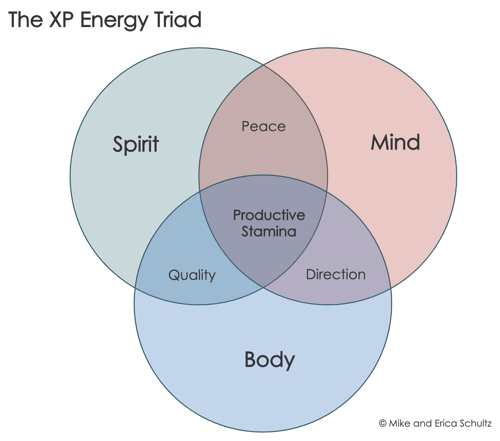
Tip 22: Mind. Concentrate Early in the Day, Minimize Decisions, Practice Positive Self-Talk and Mindfulness
- Concentrate early in the day: Early in the day, at least for most people, energy is highest. If you need to concentrate, do it in the morning when both your physical and mental fuel tanks are full.
- Minimize decisions: Decisions tax the brain. They make you mentally tired. This is why we suggest you create a weekly action plan and calendar your Investment activities, and why you should tackle your Greatest Impact Activities early in the day before you’ve made too many decisions.
- Use positive self-talk: If you’re feeling down, negative, or otherwise not in a good emotional state, it’s nearly impossible to be energetic and engaged in a task. Ask yourself, “How’s my mindset?” If you don’t feel your mental energy is in the right place, take a walk to clear your head, practice positive self-talk, meditate, breathe deeply, say, “3...2...1...Stop!”
Tip 23: Body. Eat Well, Sleep Well, and Take Care of Your Body.
You can focus on adopting the 9 Habits of The Productivity Code, but if you don’t sleep well at night, or are tired during the day for whatever reason, it’s unlikely you’ll get much done.
Likewise, the food you put in your body matters both directly and immediately, and over the long term.
Find a system that works for you to help you eat well, sleep well, and exercise to maximize your energy. You’ll improve your ability to become extremely productive and feel a whole lot better.
In fact, our research confirms that not only are The Extremely Productive 2x more likely than The Rest to be active and physically fit, but those qualities are also key drivers of happiness, with the happiest people 1.7 times more likely to possess them.
Tip 24: Spirit. Take Treasured Time, Find Your Spiritual Path
Finding spiritual energy is a personal journey, but here are a few practical actions you can take to help:
- Take Treasured time: The mental health benefits of leisure activities include lower levels of depression and improved physical and psychological status. Our research shows taking Treasured time is a key driver of happiness and that the most productive people take Treasured time more than twice as often as The Rest.
- Find meaning in your time: Set goals that, should you achieve them, really mean something to you. If you have a specific life destination, and truly want to arrive there, energy will find you.
- Go outside to feel alive: Being outside in nature makes people feel more alive. Just 20 minutes outdoors is often enough.
Habit 9: Right the Ship
Changing habits and being productive isn't easy. We all get derailed and lose focus sometimes.
Even the most productive people go off course, but they’re 5.3 times more likely than The Rest to recover quickly. They describe it like this: “If I find myself doing an activity or continuing with a habit I want to stop, I usually stop quickly once I realize I should.”
Tip 25: Practice Free Won’t
Deeply ingrained habits—e.g., checking your phone while working—happen almost without thought. The thought is there, but it’s so fast that we start doing the behavior without seeming to initiate it consciously.
While conscious thought may or may not cause us to initiate certain behaviors, conscious thought can cause us to stop that behavior. So perhaps we have no “free will,” but we certainly have “free won’t.”
The key is getting back on track—and staying on track—for longer periods. Earlier we shared how to ignite proactivity by saying "3, 2, 1…Go." The reverse also works to stop an undesired activity. Simply say, "3, 2, 1…Stop!"
Tip 26: Make Micro Change
If you're having a hard time making any of these changes in full, try making a micro-change. Cut it down and start there. Can't sprint for 20 minutes? Try starting with five.
Maybe you know you can't finish a task in five minutes—that’s fine. Once you're into a particular task, you keep going because you're over the activation energy hump, and you're getting satisfaction and pleasure out of the progress you're making.
Tip 27: Make a Commitment Contract
If you’re serious about doing what you’ve committed yourself to do, you can make a commitment contract—putting your money and reputation on the line. According to researchers, people who make a commitment contract increase their chances of success up to 200 percent. Putting money at stake increased the chances of success by up to 300 percent. That’s triple the likelihood you’ll succeed!
Try making a commitment contract for yourself, putting a little something on the line on Stickk.
Learn How to Be Productive
Staying productive keeps you invigorated, motivated, engaged, and ready for the next challenge. It’s not always easy to stay focused, but by adopting these productivity tips and strategies, you give yourself the tools to achieve success.
To learn more about these productivity keys, habits, and tips, download our ebook, Unlocking The Productivity Code. |






